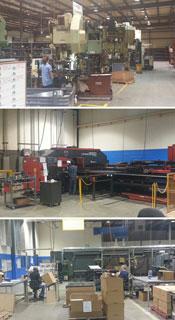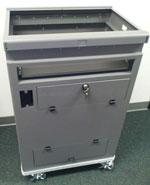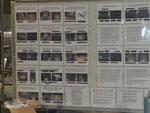Senior Editor
- FMA
- The Fabricator
- FABTECH
- Canadian Metalworking
Categories
- Additive Manufacturing
- Aluminum Welding
- Arc Welding
- Assembly and Joining
- Automation and Robotics
- Bending and Forming
- Consumables
- Cutting and Weld Prep
- Electric Vehicles
- En Español
- Finishing
- Hydroforming
- Laser Cutting
- Laser Welding
- Machining
- Manufacturing Software
- Materials Handling
- Metals/Materials
- Oxyfuel Cutting
- Plasma Cutting
- Power Tools
- Punching and Other Holemaking
- Roll Forming
- Safety
- Sawing
- Shearing
- Shop Management
- Testing and Measuring
- Tube and Pipe Fabrication
- Tube and Pipe Production
- Waterjet Cutting
Industry Directory
Webcasts
Podcasts
FAB 40
Advertise
Subscribe
Account Login
Search
Integrating stamping, fabricating, and assembly
How a new assembly department became a reality
- By Tim Heston
- July 12, 2013
- Article
- Assembly and Joining

Figure 1: Genesee started in stamping (top), expanded into fabrication (center), and last year launched an assembly department.
Genesee Group launched in 1978 as a contract stamper. Its forte was short-run, single-stage-type setups using modular tooling for small and medium-sized runs; many customers ordered 5,000 to 10,000 pieces a year. Today the company has two divisions: A&B Genesee in Mount Juliet, Tenn., a plant that produces stampings for automotive exhaust systems; and Grand Prairie, Texas-based Genesee Stampings and Fabrication.
The “and Fabrication” part of the name has become more important in recent years.
The Texas plant offers contract fabrication, stamping, in-house machining that mainly supports tooling needs and components for sheet metal parts, and, within the past year, assembly services (see Figure 1).
“Fabrication was implemented to perform concept, preproduction-type parts, with very little capital investment from the customer, because it didn’t require tooling.”
So said National Sales Manager George Naseef, referring to the company’s foray into low-volume punching and bending in the 1980s. At first the split between stamping and fabrication capability was distinct. Cutting on a punch press and (especially) bending on a press brake just couldn’t match the accuracy and geometric complexity possible in stamping.
But over the years the capabilities of fabrication equipment have improved dramatically. Tolerances in laser cutting can be plus or minus just a few thousandths of an inch, and the same goes for bending. More and more, the choice between stamping and fabrication isn’t about quality concerns, the ability to hold a tolerance for this radius feature or that edge. It’s now more about volume, order frequency and predictability, and (considering the tooling costs) the longevity of the part in the marketplace.
“Customers want smaller quantities more frequently,” Naseef said. “People used to buy in anticipation of what they would be selling tomorrow. Now they’re buying what they already sold today. Nobody wants to keep inventory anymore, especially in an unpredictable economy.”
This has shifted Genesee’s focus and, for that matter, the focus of metal manufacturing as a whole. Historically, most of Genesee’s revenue came from the stamping side, the traditional home of high-volume, high-dollar jobs. Now the ratio has switched. Today about 60 percent of revenue comes from the fabrication side.
Expanding Capabilities
Up until a year ago, the company’s assembly capability consisted mainly of inserting hardware and some minor welding. The evolution toward more complete assembly operations, though, began in earnest several years ago during the initial stages of the economic rebound, when managers noticed far more growth occurring on the fabrication side of the business.
Historically, most of the company’s parts had been small: 18 in. long or wide was a typical blank size. But when the company traded in an old 2-kW CO2 laser and invested in a Salvagnini fiber laser, it began cutting larger blank sizes, a few as large as 6 by 10 feet (see Figure 2). This was a strategic buy for Genesee’s managers, who continued to see more and more opportunities in metal fabrication.

Figure 2: The company’s fiber laser has two offloading tables, one for thin-gauge work and another for a thicker-gauge clutch plate job, a repeat order. The offloading table arrangement was built to suit the company’s product mix and part flow.
Soon thereafter a large customer had just closed a plant in another area of the country and was moving more work to an existing Texas plant, and the company was looking for additional fabrication services that involved a lot of cutting and, especially, bending. That opportunity increased Genesee’s volume and revenue, which it reinvested in the business by purchasing a 10-ft., 150-ton Amada press brake.
The fiber laser, in conjunction with two Amada turret presses and several press brakes, expanded Genesee’s fabrication capability considerably. For years the fabrication side had always complemented the stamping side of the business. Now, emerging from the recession, the stamping side seemed to be complementing the fabrication side.
As Naseef recalled, “At that point we thought, why don’t we also complement all this by enhancing our welding area and putting parts together to make assemblies?”
Expanding Into Assembly
To that end, the company expanded its welding capabilities; it now has two manual welding stations and one robotic welding system, investments that came after some additional work from a major OEM that, again, moved more production to Texas. Soon the company plans to add two additional manual welding stations.
The core of the company’s transformation has focused on final assembly, which required shop floor space, and in 2012 there wasn’t enough of it. The shop had stamping presses on one side, several turret punches, a laser system, and a press brake on the other, with production management and scheduling personnel in the center.
Production management and scheduling was moved to the front office, and a row of secondary-operation stamping presses was eliminated. The company does run progressive tooling, and with more of the business shifting toward fabrication, the need for secondary presses just wasn’t there.
On the fabrication side, the press brakes were moved adjacent to one another, and (at this writing) a turret press was to be moved nearby as well. The offloading tables on the laser also aren’t far from the brakes. All this not only saved space, but also shortened travel time between cutting and bending, though managers made sure to leave room for a possible second laser and tower system.
The laser’s two offloading tables were placed to handle Genesee’s part flow. One table handles thin-gauge parts, while the second table holds heavy-gauge clutch plates, a repeatedly ordered item. The clutch plates are 0.5 in. thick, so the fiber laser doesn’t cut them extraordinarily fast. But as Naseef explained, the cut quality exceeds that of the older laser. The fiber laser does, of course, cut thin gauge extremely quickly, so it can meet the demand of downstream processes in short order. Between those jobs, the laser switches to slower cutting of thicker-gauge material.
Moving equipment freed up space in the middle of the shop for an assembly area, which now accepts parts from both the stamping and fabrication sides of the plant. The assemblers may join 40 piece parts or more—a far cry from simple piece-part production (see Figures 3 and 4).
The assembly space includes an additional 13,000 square feet for a customer that, at this writing, had a need for LED lighting assembly. The company brought on an additional programmer and engineer experienced in electromechanical assembly, critical for the company’s forthcoming LED assembly work and whatever future opportunities that may come down the pike.
“We’re working with a few customers right now,” Naseef said. “They are looking to bring back this work from China. The primary reasoning I’m hearing is that the lead-times in China have been extended to 12 or 15 weeks, and then you have to buy a container-full. So it’s about the lead-time and cash outlay required for the higher volume of parts that they don’t necessarily need immediately.”
Strengths From Both Sides
Genesee’s shop floor is a bit of a manufacturing microcosm showing the strengths of myriad sheet metal manufacturing technologies. Stamping may be less flexible than fabrication because of the hard tooling costs involved. Still, because the presses are somewhat low-tonnage (the largest model is 350 tons), dies aren’t massive, and the staff has perfected quick die changeout, so that the press is down a half-hour between jobs at most.
From a capacity standpoint, stamping has plenty. Today Genesee’s stamping presses alternate between piece-part jobs that can be completed and shipped quickly and more complex jobs requiring several pieces to be stamped and sent to the assembly area. The stamping area has flexibility from a capacity perspective, because the presses can produce on-demand quickly. They just aren’t flexible when it comes to design changes. What the fabrication side lacks in capacity it makes up for in its ability to take on new projects without tooling development.
Market trends have pushed more jobs toward the fabrication side of the business, but having both stamping and fabricating expertise may give the shop a competitive advantage. If the tool is already developed, the per-piece cycle time on a stamping press is hard to beat, and, of course, the time savings add up with higher volumes. Jobs involving fabrication range in the hundreds or several thousand per order, but a few stamping-exclusive orders call for 80,000 parts or more. That big volume range and manufacturing offerings have helped garner a diverse customer base.
Long term, the company wants assembly to remain complementary to its core fabrication and stamping competencies. Like most firms in U.S. manufacturing, Genesee Group is somewhat small, with 58 employees in the Texas location and another 60 in Tennessee.
Managers also don’t want to be everything to everybody. “We still want to be a metal former and fabricator,” Naseef said, not a contract manufacturer that handles all elements of production.
About Productive Space
All this really couldn’t have happened without one more critical element: the shift from batch production to a lean flow with smaller lot sizes. Years ago the company produced common parts in batches large enough to satisfy customer demand for several months, which required shelf space for all the work-in-process (WIP) and finished goods those large batches produced. For piece-part production, stacking or storing finished goods on racks wasn’t terribly complicated. But expansion into assembly of diverse, often complex products changed the situation.
When the company reduced its batch sizes and, hence, WIP and finished goods, it could eliminate an entire storage rack, freeing up space needed for assembly and expanded fabrication capabilities. “We talked to customers about switching from the batch to the lean mentality,” Naseef said. “The batch mentality really is just a security blanket. Customers always wanted us to keep a certain amount of products on the shelf to take care of their spikes in volume.
“We explained it this way: Normally your spikes in demand reduced our finished goods supply anyway. What you’re really looking for is flexibility and availability to be able to produce above and beyond. You couldn’t do that, because I was tying up shop hours in building products for future use, so I never had the flexibility to build the product you need today.
“So by producing only what we need to ship immediately, if you come to me and demand more products, I now have those freed-up shop hours to work with. Before, I would tell you that I couldn’t run products you need today, because I was too busy running products you’ll need tomorrow.”
That’s the textbook rationale for lean, theory of constraints, and other improvement methodologies. As Naseef explained, market conditions have made that rationale more palpable to customers. The competitive environment and globalization have made future demand more difficult to predict than ever. So why require suppliers to produce products that might be needed in the future, especially when it prevents them from producing a job that is needed immediately?
Customers accepting that rationale allowed Genesee to reduce its finished goods stock and, ultimately, turn cash-draining inventory space into productive, revenue-generating space. Without that, Naseef said, the company’s new assembly operation probably never would have come to fruition.
About the Author

Tim Heston
2135 Point Blvd
Elgin, IL 60123
815-381-1314
Tim Heston, The Fabricator's senior editor, has covered the metal fabrication industry since 1998, starting his career at the American Welding Society's Welding Journal. Since then he has covered the full range of metal fabrication processes, from stamping, bending, and cutting to grinding and polishing. He joined The Fabricator's staff in October 2007.
Related Companies
subscribe now

The Fabricator is North America's leading magazine for the metal forming and fabricating industry. The magazine delivers the news, technical articles, and case histories that enable fabricators to do their jobs more efficiently. The Fabricator has served the industry since 1970.
start your free subscription- Stay connected from anywhere

Easily access valuable industry resources now with full access to the digital edition of The Fabricator.

Easily access valuable industry resources now with full access to the digital edition of The Welder.

Easily access valuable industry resources now with full access to the digital edition of The Tube and Pipe Journal.
- Podcasting
- Podcast:
- The Fabricator Podcast
- Published:
- 04/16/2024
- Running Time:
- 63:29
In this episode of The Fabricator Podcast, Caleb Chamberlain, co-founder and CEO of OSH Cut, discusses his company’s...
- Industry Events
16th Annual Safety Conference
- April 30 - May 1, 2024
- Elgin,
Pipe and Tube Conference
- May 21 - 22, 2024
- Omaha, NE
World-Class Roll Forming Workshop
- June 5 - 6, 2024
- Louisville, KY
Advanced Laser Application Workshop
- June 25 - 27, 2024
- Novi, MI

































